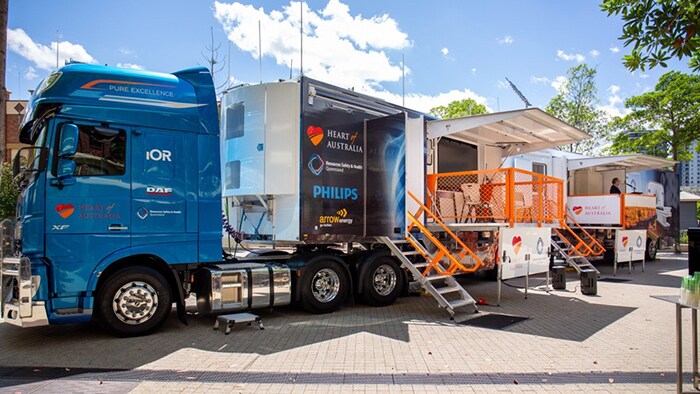Teaming up to advance health equity
Jun 22, 2023 - Reading time 9-11 minutes
Billions of people around the world can’t access the health services they need. Though needs are typically greatest in low-resource settings, serious health disparities are also present in places with greater resources.

An equal chance at health and well-being
Today, too many people experience poor health outcomes, which is unfair and preventable. These are health inequities. Even in countries with well-funded health systems, people in marginalized and underserved communities often cannot access the health services they need. In 2020, for example, the maternal mortality rate for Black women in the US was nearly triple that of white women. [1]
COVID-19 intensified this situation, disproportionally impacting underserved and marginalized populations, broadening existing health disparities, and forcing vulnerable people into even more precarious positions. [2] Gaps such as higher rates of poor health and disease among certain racial and ethnic minority groups [3] have been brought into sharper focus post-pandemic, prompting a global call to respond to systemic inequalities. [4]
What makes this situation even more frustrating is that beyond being unfair and unacceptable, health inequities are also avoidable. The underlying issues are known, and the technologies and interventions to support people in attaining full health are available.
Health equity is a “moral and financial” imperative [5] achieved when all people – no matter who they are or where they live – can reach their full potential for health and well-being. [6] For health equity to exist, people need to be able to access quality care without experiencing economic, social, or other obstacles.
Digital health innovations bring equitable care closer to patients
What will it take to ensure all people can access quality care? One of the ways healthcare innovators like Philips can respond to health inequities is by developing responsible digital technologies that make care more accessible and equitable. Technologies that harness the power of AI, for example, hold great promise for improving health equity – especially for those living in more remote places.
As well, mobile solutions can offer new ways to bring critical care closer. Take Australia, for example. Almost 30% of the population lives in regional and rural areas. [7] People often have to take time off work and arrange for transportation to seek the care they need in urban/metro areas. Add to that the issue of affordability, and the result is that people often neglect seeking timely care.

Working with Heart of Australia, an initiative founded by cardiologist Dr. Rolf Gomes, Philips helped create a ‘hospital on wheels’ capable of bringing diagnostic imaging services, such as X-ray and CT, to hard-to-reach communities.
“It's all about bringing healthcare to people who would otherwise miss out,” says Dr. Gomes. “Australia is a very big country with scattered populations. Trying to access healthcare for a lot of those patients, especially aboriginal and Torres Strait Islander patients, is a real challenge – and in many instances, basically impossible. So here we bring not just the doctors, but the toolbox.”
In the US, another partnership between New York’s Roswell Park Comprehensive Cancer Center and Philips is helping bring life-saving cancer screening sooner to those who need it – especially medically underserved and racially diverse populations – via a similar mobile screening solution.
Collaborative efforts like these are what it will take to accelerate the digital transformation of healthcare and build stronger, more equitable health systems that support health for all.
Monitoring solutions and mobile apps address maternal health disparities
Globally, about 287,000 women died from mostly preventable causes related to pregnancy and childbirth in 2020. [8] The majority of these deaths occur in low- and middle-income countries. However, the rate of women in the US dying in childbirth is surging, according to the Centers for Disease Control and Prevention (CDC), with disproportionally high death rates among Black women. [9]
Most of these maternal deaths are preventable. Technologies that help identify high-risk pregnancies sooner and provide ongoing monitoring, care access, and tools to support healthy behaviors can help close maternal care gaps.
In the US, Philips and NUVO are collaborating with clinical partner Banner Health on a remote fetal monitoring solution that pairs Philips’ perinatal analytics and visualization software, with a fetal monitoring belt that can be applied directly by the mother without a clinician being physically present.

Pilots in Colorado and North Dakota focus on increasing access and adherence to prescribed care plans in remote and rural areas. The solution enables monitoring of maternal and fetal heart rates and uterine activity without the need to go to a hospital or clinic. This could help address what are known as ‘maternity care deserts’ – areas that lack maternity care resources, obstetric providers, and hospitals or birth centers offering obstetric care. [10] In Brazil, where maternal mortality has increased sizably in recent years – from 57 deaths per 100,000 births in 2019 to 107 deaths in 2021 [11] – expectant mothers can access personalized health information using Pregnancy+ thanks to a partnership with UNFPA.
Mobile apps are another way to tackle maternal health disparities. Available in 22 languages and with more than 60 million global downloads to date, the Philips Pregnancy+ app gives expectant mothers access to timely health education and pathways for connecting to local resources and care providers.
Pregnancy+ is also being used in the US by the Michigan Department of Health and Human Services (MDHHS) to address maternal health inequities. According to the National Institutes of Health (NIH), the US has the highest maternal mortality rate among high-income countries and is the only one where maternal mortality is increasing among Black women. [12]

In response, MDHHS has launched an initiative to remove healthcare access barriers such as race, ethnicity, insurance type and income. As part of the initiative, MDHHS uses Pregnancy+ to connect Medicaid-eligible families to vital state resources and support programs, as well as provide access to customized content.
“MDHHS is excited to be able to offer the Pregnancy+ app to Michigan families to support them during this exciting time in their lives,” said Dr. Natasha Bagdasarian, chief medical executive. “We want to ensure they are able to access the resources they need, and to learn about important topics including immunizations, hearing screening, breastfeeding and other information designed to improve the health of moms and babies.”
So far, more than 27,000 Michigan families have been reached through Pregnancy+.

Partnering across sectors to achieve health equity
Each of the innovations described above requires strong cross-sector partnerships. As private-sector companies ramp up their involvement in social impact efforts, the need for model approaches, shared insights and cross-sector learning communities increases. The Health Data Governance Principles, a global set of principles created to help safeguard health data in the absence of comprehensive government policies, are a great example of a model approach. Weak health data governance risks exacerbating health inequities. This framework offers essential guidance for the equitable governance of health data when deploying and scaling digital health solutions.
Involving the right entities from the outset is critical. Delivering impactful and equitable health outcomes over the long term takes partners with complementary strengths working closely with the communities being served and with those involved in healthcare delivery at the local level.
Multi-sector collaborations are important as they enable companies to grow their expertise and adapt more quickly in their efforts towards health equity. Here are a few good examples:
Shared platforms like these provide opportunities to share knowledge, build competencies, and contribute to larger policy discussions.

How private companies can take action on health equity
Increasingly, companies are embedding health equity as a guiding value across their organizations. Private-sector companies can help drive progress by: Effective corporate ESG frameworks make sure tangible actions are in place with measures to track results. Setting interim goals, measuring progress, and working and learning along with partners and communities is how we’ll get there.
Racing toward a more equitable and healthy future
Digital innovation is a critical engine for driving health equity. Emerging technologies present new opportunities for accessing health resources and services outside conventional care centers – often with the added benefits of lower costs, quicker service delivery, and better environmental sustainability.
Accelerating the digital transformation of health in an equitable way will require out-of-the-box thinkers behind the wheel and a diverse team of collaborators from across the health ecosystem. Every organization, even those outside the health sector, has a role to play in making sure no one is left behind. Lives are at stake if we don’t win this race.
Additional resources: The US Health Resources and Services Administration (HRSA) defines health equity as the absence of disparities or avoidable differences among socioeconomic and demographic groups or geographical areas in health status and health outcomes. Office of Health Equity | HRSA https://eu.usatoday.com/story/news/health/2023/03/16/maternal-mortality-rate-surging-again/11465170002/
References [1] Centers for Disease Control and Prevention, Maternal Mortality Rates. February 2022. [2] Deloitte, 2022 Global Health Care Outlook. 2021. [3] Centers for Disease Control and Prevention, What is Health Equity?. July 2022 [4] United Nations, UN Response to COVID-19. 2021. [5] World Economic Forum, Global Health Equity Network: A Business Case for Health Equity. January 2023. [6] World Health Organization, Health Equity and Its Determinants. April 2021. [7] Australian Institute of Health and Welfare, Rural and remote health. July 2022 [8] World Health Organization, Maternal mortality. February 2023 [9] Centers for Disease Control and Prevention, Maternal Mortality Rates in the United States. February 2022. [10] March of Dimes, Maternity Care Deserts Report. 2022. [11] The Lancet Regional Health, High maternal mortality rates in Brazil. August 2022. [12] National Institute for Health Care Management (NIHCM) Foundation, The Uneven Burden of Maternal Mortality in the US, August 2022.
Stay up to date and subscribe
Sign up to stay informed and receive information on healthcare innovation, straight to your inbox








